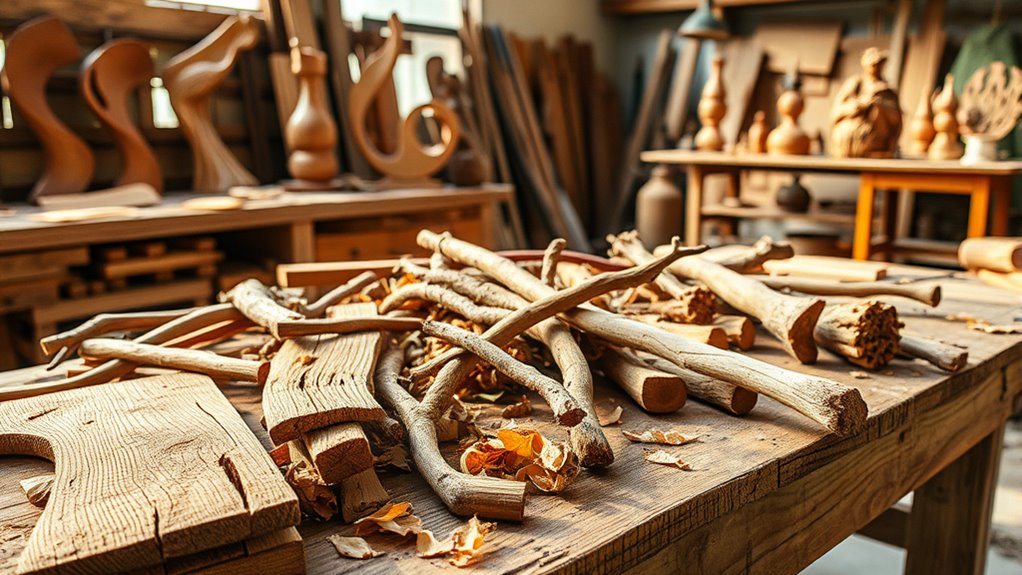Repurposing wood waste offers creative, eco-friendly solutions to reduce landfill waste and conserve resources. You can transform scrap wood into furniture, artwork, shelves, or holiday decorations with simple tools and DIY techniques. Reusing old windows, pallets, and branches not only saves money but also adds rustic charm to your home. By exploring these ideas, you’ll discover how repurposing supports sustainable living and benefits the environment, with more inspiring projects waiting to be explored.
Key Takeaways
- Transform reclaimed wood into home decor items like picture frames, shelves, and wall art for eco-friendly interior design.
- Use scrap wood for DIY furniture projects, such as tables, benches, or small storage units, reducing waste and saving costs.
- Create garden accessories like bird nests, planters, or outdoor signs from driftwood and leftover lumber.
- Repurpose old windows and pallets into decorative pieces, such as picture displays or rustic room dividers.
- Incorporate wood waste into craft projects like holiday decorations, personalized signs, or children’s toys for sustainable creativity.
Exploring Types and Sources of Wood Waste
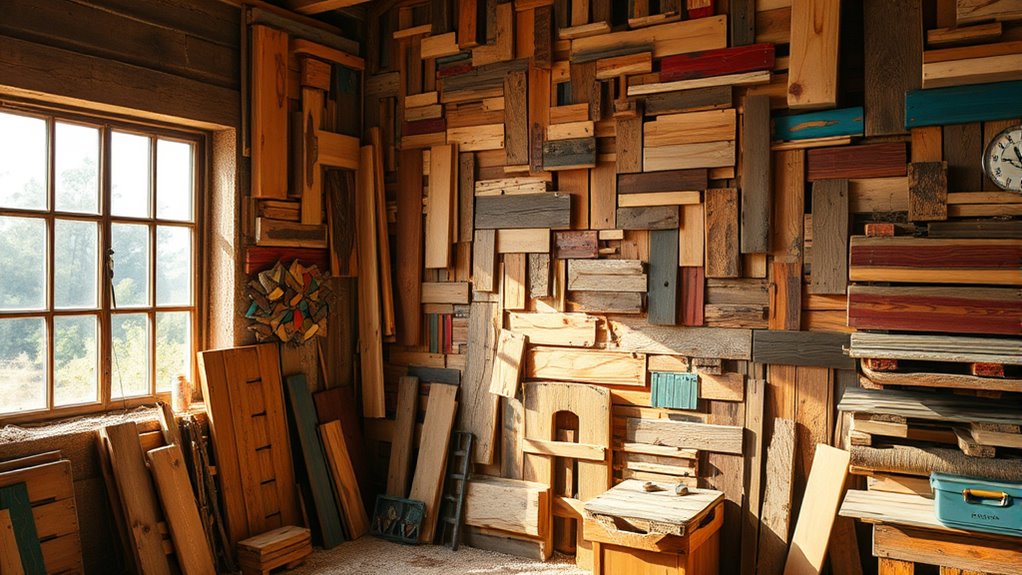
Have you ever wondered where all the wood waste comes from? It comes from a variety of sources, including construction sites, demolition projects, DIY home improvements, and industrial manufacturing. Wood waste includes old windows, driftwood, scrap lumber, sawdust, and tree branches. You’ll also find discarded items like old furniture, packaging, and materials used in movie sets. Construction and demolition activities are major contributors, generating over 12 million tons of wood waste in the US in 2018 alone. This waste often ends up in landfills, but it doesn’t have to be discarded. Recyclable wood waste can be repurposed into decorative items, furniture, and craft projects, helping to reduce waste and promote sustainability. Understanding these sources is the first step toward smarter waste management. Wood waste recycling is gaining momentum as a sustainable practice that reduces environmental impact, supported by innovative recycling techniques. Proper sorting and processing are essential for effective wood waste reuse, ensuring that more material can be transformed into useful products. Additionally, waste management practices play a vital role in maximizing the reuse potential of wood waste. Moreover, educating communities about sustainable waste practices can further enhance recycling efforts and reduce landfill dependency.
Innovative Ideas for Recycling and Repurposing
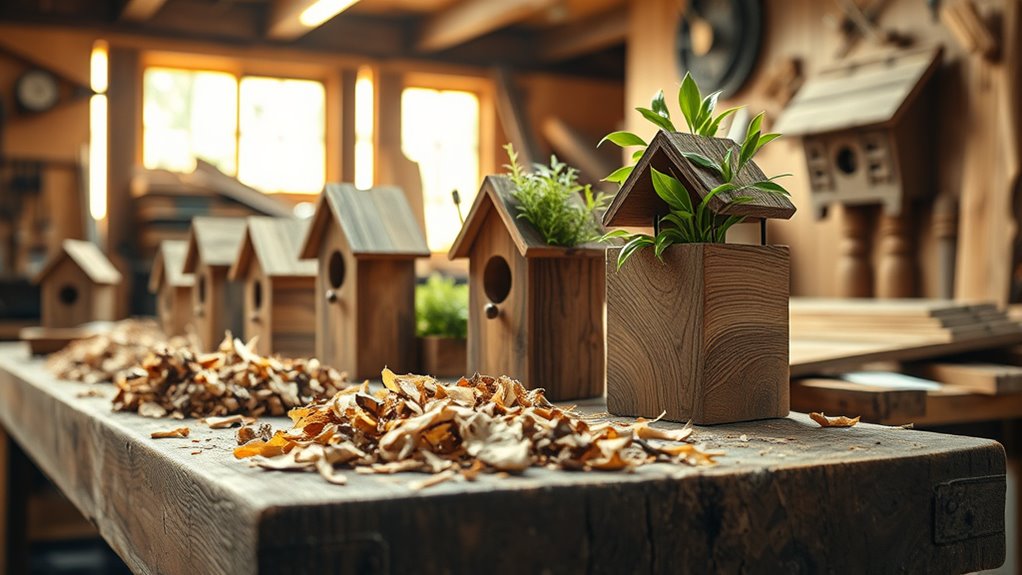
Innovative recycling and repurposing of wood waste offer practical ways to reduce landfill contributions and enhance sustainable home design. You can transform discarded wood like old windows, scraps, and driftwood into functional items. Creative ideas include making furniture, wall art, bird nests, and holiday decorations. Many DIY projects use simple tools and techniques, making recycling wood waste accessible. Online platforms and tutorials provide endless inspiration and plans for projects, helping you turn scrap wood into beautiful, useful pieces. By actively recycling wood waste, you conserve natural resources and promote eco-friendly living. Incorporating sustainable practices into your projects can further amplify your positive environmental impact. Here’s a quick overview to spark your creativity:
| Material Type | Repurposing Ideas | Tools Needed |
|---|---|---|
| Old Windows | Picture frames | Saw, paint |
| Scraps | Small furniture | Hammer, nails |
| Driftwood | Garden decor | Sandpaper, glue |
| Pallets | Shelves, furniture | Drill, saw |
| Branches | Wall art, nests | Scissors, paint |
Inspiring DIY Projects With Reclaimed Wood

You can transform reclaimed wood into simple projects like picture frames, shelves, or even small furniture pieces that add charm to your home. Creative ideas such as wall art or decor made from driftwood and scrap lumber let you personalize your space while being eco-friendly. These DIY ventures are budget-friendly and inspire you to repurpose wood waste into stylish, functional items. Incorporating sustainable woodworking practices can help you select project ideas that resonate with current home decor styles and attract more interest. Additionally, exploring reclaimed wood can enhance the durability and appeal of your handmade creations. Embracing environmentally conscious techniques ensures your projects support eco-friendly initiatives while showcasing your craftsmanship.
Easy DIY Craft Ideas
Reclaimed wood offers a fantastic starting point for easy DIY craft projects that anyone can enjoy. With just a few simple Materials, you can transform scrap wood from pallets or discarded furniture into charming home accents. These DIY Projects are perfect for beginners since they require minimal tools and skills. Using reclaimed wood not only reduces solid waste but also turns leftover building materials into functional pieces. Popular ideas include making picture frames, plant stands, or small furniture pieces that add rustic character to your space. Plenty of online tutorials and step-by-step guides make these projects accessible, breaking down complex tasks into manageable steps. Embracing reclaimed wood for your crafts promotes eco-friendly living while giving new life to materials that might otherwise go to waste. Additionally, understanding the benefits of secure merchant services can help support your small business endeavors as you expand your craft offerings.
Creative Home Decor
Transforming reclaimed wood into creative home decor allows you to add personalized, rustic charm to your space while promoting sustainability. Reclaimed wood lends itself well to making picture frames, wall art, and custom furniture that showcase your unique style. You can craft decorative items like wall hangings, shelves, and rustic signs, giving your interiors a handcrafted touch. Many online tutorials guide beginners through simple projects such as step stools, planters, and coat racks, all made from recycled wood. Using reclaimed wood in your decor helps reduce waste and minimizes environmental impact. Incorporating sustainable investment practices and wall decor inspiration ideas can further elevate your space. Platforms like DIY blogs and furniture websites often feature innovative ideas—transforming old pallets, windows, and scrap lumber into beautiful, functional pieces that reflect your creativity and commitment to sustainability. Additionally, exploring community engagement can connect you with other enthusiasts and inspire new project ideas. Embracing personal development principles during your projects can enhance your skills and boost your confidence in DIY craftsmanship. Incorporating eco-friendly filtration technology into your projects can also improve indoor air quality and create healthier living environments.
Cost-Effective Projects
Creating DIY projects with reclaimed wood is a budget-friendly way to upgrade your home while supporting sustainability. Reclaimed wood is often free or inexpensive, making it ideal for cost-effective projects. You can find hundreds of online plans and tutorials to craft furniture, decor, and functional items from recycled wood. Items like step stools, storage units, kids’ furniture, and wall art can be made easily, saving you money compared to buying new. Using scrap pieces of different sizes enhances savings and allows for customized projects like shelves or plant stands. Crafting with reclaimed wood not only cuts costs but also promotes eco-friendly practices by reducing waste and decreasing demand for new lumber. Additionally, repurposing wood can help reduce the environmental impact associated with wood waste disposal. Incorporating reclaimed wood into your projects can also improve the aesthetic appeal of your space with unique, rustic charm. With a little creativity, you can turn scrap wood into beautiful, functional pieces for your home.
Environmental Advantages of Wood Waste Recycling
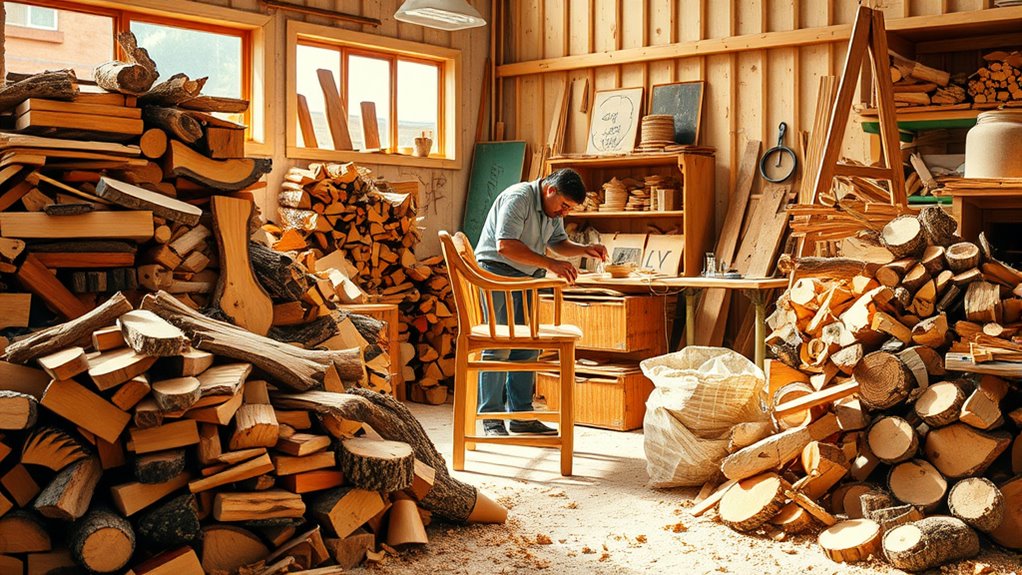
Recycling wood waste helps cut down on landfill contributions, which made up over 12 million tons of waste in 2018. By turning scrap into new products, you conserve natural resources and reduce the need for deforestation. Plus, this practice lowers greenhouse gas emissions, supporting a healthier environment for everyone. Incorporating creative practices into recycling initiatives can further foster innovative solutions and community engagement. Implementing sustainable methods can maximize environmental benefits and promote long-term ecological balance. For example, utilizing techniques inspired by traditional Italian culinary heritage demonstrates how blending innovation with cultural preservation can enhance sustainability efforts. Additionally, understanding GMC tuning techniques can inspire similar innovative approaches to repurposing waste, emphasizing the importance of customized solutions for optimal results. Exploring regulatory compliance can also ensure that recycling projects adhere to current environmental standards and avoid legal complications.
Reduces Landfill Waste
By diverting wood waste from landfills, you help reduce the amount of space needed for disposal and prevent environmental contamination. Recycling wood waste keeps it out of landfills, which is essential since, in 2018, the US landfill received 12.2 million tons of wood waste—8.3% of total municipal solid waste. When wood is recycled instead of disposed of, it decreases the need for new landfill space and lowers methane emissions, a potent greenhouse gas released during decomposition. Proper reuse and recycling of wood waste also support waste reduction goals and sustainable waste management practices. By choosing to recycle, you contribute to a cleaner environment, reduce pollution, and promote more responsible disposal methods. Additionally, data management techniques such as those supported by indexes like The Graph can improve the tracking and verification of recycled materials throughout the supply chain. Your efforts make a meaningful difference in managing waste responsibly.
Conserves Natural Resources
Reusing wood waste plays a crucial role in conserving natural resources by reducing the demand for virgin timber. When you recycle wood waste, you help protect forests from deforestation and overharvesting. This process minimizes environmental impact by decreasing landfill waste and greenhouse gas emissions. Using reclaimed wood in manufacturing supports sustainable resource management and slows depletion of natural resources. Recycling wood waste also allows you to recover valuable components like lignin and cellulose, promoting a circular economy. To see the impact clearly, consider this table:
| Benefit | How it helps | Environmental impact |
|---|---|---|
| Reduces virgin timber demand | Less logging needed | Preserves forests, prevents deforestation |
| Minimizes landfill waste | Less wood waste in landfills | Lowers greenhouse gases |
| Supports sustainability | Reclaimed wood use | Sustainable resource management |
| Promotes circular economy | Recycling valuable components | Less resource depletion |
Lowers Carbon Emissions
Since reducing carbon emissions is essential for combating climate change, repurposing wood waste offers a significant environmental advantage. Recycling wood waste reduces the demand for virgin timber, which cuts down deforestation and lowers associated carbon emissions. When you upcycle wood debris into furniture or building materials, you create new products with a smaller carbon footprint than manufacturing from raw resources. Proper disposal and recycling of wood waste also prevent methane emissions from landfills, a potent greenhouse gas. Additionally, converting wood waste into biofuels and energy sources further decreases overall carbon emissions in energy production. By embracing wood waste recycling, you support sustainable practices that help cities and industries meet their carbon reduction goals, making a tangible difference in fighting climate change.
Practical Scrap Wood Crafting and Home Decor
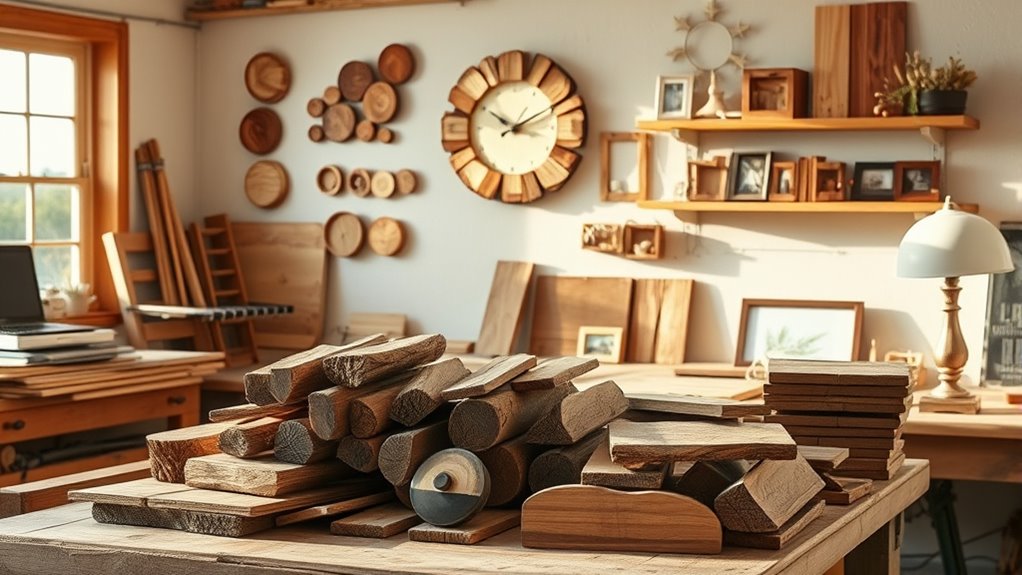
Practical scrap wood crafting offers an easy and affordable way to create functional and decorative items for your home. With simple tools like hammers, drills, and sanders, you can turn leftover wood into DIY step stools, storage units, or kids’ furniture. For home decor, try making wall art, holiday decorations, or rustic furniture like TV stands and plant holders. These projects promote sustainable waste management by giving new life to materials that would otherwise be discarded, reducing waste. Plus, they add a personal touch to your space. To inspire you, here’s a quick guide:
| Project Type | Materials Needed |
|---|---|
| Wall Art | Scrap wood, paint, nails |
| Holiday Decorations | Small leftover pieces, glue |
| Furniture Pieces | Larger scraps, screws |
| Storage Solutions | Various-sized leftover wood |
Creative Products Made From Discarded Wood
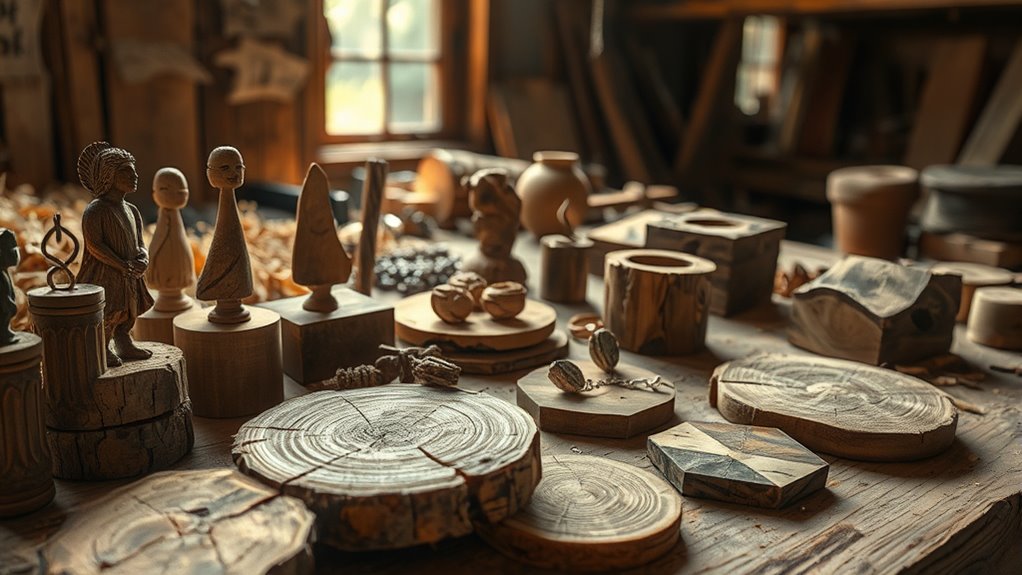
Transforming scrap wood into creative products showcases how discarded materials can become valuable assets for your home and environment. Upcycled wood allows you to craft unique decor items like wall art, shelves, and picture frames that add character and sustainability. Innovative products, such as forest crayons made from recycled Japanese cedar and cypress, highlight eco-friendly uses of wood waste with vibrant, natural pigments. Construction debris, including PSL beams and plywood, can be repurposed into culturally inspired furniture, blending tradition with modern design. Additionally, upcycled wood shavings and organic waste are turned into acoustic panels and soundproofing tiles, combining functionality with creativity. Embracing these ideas supports circular economy initiatives, reduces landfill waste, and helps you create beautiful, eco-conscious pieces for your space.
Developing Sustainable Systems for Waste Management
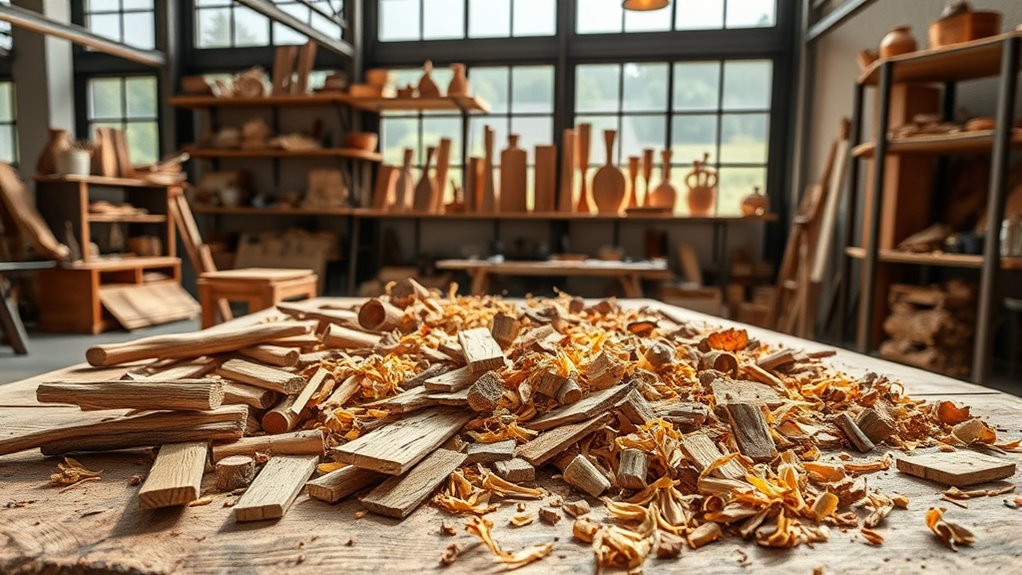
How can communities create more sustainable wood waste management systems? By adopting sustainable waste management practices, you can reduce environmental impact and promote reuse. Here’s how:
Adopting sustainable waste practices reduces environmental impact and encourages resource reuse in communities.
- Segregate wood waste from other debris to make recycling and repurposing easier.
- Develop localized processing facilities, like small biomass plants, to cut transportation emissions and boost local economies.
- Use innovative technologies such as ionic liquids to efficiently convert wood waste into valuable materials, aligning with circular economy principles.
- Establish standardized guidelines and incentives that encourage industries and communities to adopt eco-friendly disposal and reuse methods.
Creating all-encompassing platforms for sharing DIY projects and ideas also fosters community engagement. These steps help build sustainable waste management systems that maximize wood waste as a resource, not a burden.
Frequently Asked Questions
What Can I Do With Waste Wood?
When you wonder what to do with waste wood, you can get creative and eco-friendly. Turn old windows, scrap lumber, or driftwood into decorative wall art, picture frames, or shelves. Use scrap wood for DIY furniture like coffee tables or stools. Make bird nests from cedar or holiday decorations from leftover pieces. You can also craft practical items like plant stands or fun kids’ furniture, all while supporting sustainability.
What Is Used for Repurposed and Reused Wood Wastes?
Think of the timeless craft of the carpenter’s hand—used for repurposed wood waste. You can transform old windows into charming picture frames, scrap lumber into furniture, or driftwood into art pieces. Construction debris like plywood scraps and sawdust can be turned into eco-friendly packaging or mulch. Just remember, handle any treated or chemical-laden wood carefully, ensuring safety and environmental responsibility as you give new life to discarded wood.
What Can You Do With Scrap Wood Recycling?
You can turn scrap wood into a variety of useful and creative projects. Use it to build furniture, garden planters, or wall decor. DIY enthusiasts often craft bird nests, stools, or storage solutions from leftover pieces. Recycling your scrap wood helps reduce landfill waste and supports a circular economy. Plus, utilizing specialized recycling centers guarantees proper disposal, making your efforts eco-friendly and resourceful while giving discarded wood a new life.
How Do You Get Rid of a Lot of Scrap Wood?
When you have a lot of scrap wood to get rid of, start by sorting it into recyclable, reusable, or waste categories. Take the recyclable wood to a local recycling center or MRF. Donate usable pieces to community groups or schools for projects. For waste, use specialized disposal services to guarantee proper handling. You can also explore creative reuse options like making furniture or garden crafts to give the wood a new purpose.
Conclusion
By exploring creative ways to repurpose wood waste, you not only reduce environmental impact but also open endless possibilities for DIY projects and unique home decor. Embrace the mindset that “waste not, want not,” and turn discarded wood into beautiful, functional pieces. Every small effort counts toward a more sustainable future, so get inspired, start recycling, and let your creativity breathe new life into what others see as trash.
